Taxation Analysis of ERM Power Limited's Annual Report 2017
VerifiedAdded on 2020/05/28
|8
|1976
|111
AI Summary
The analysis presented here evaluates ERM Power Limited's adherence to AASB 112 in its annual report for 2017, particularly focusing on the company's treatment of taxation activities. It highlights how the company records and reports current tax liabilities and deferred tax assets, which are significant for understanding its financial health. The evaluation notes the complexity involved in reconciling differences between tax amounts across various financial statements due to factors like current tax liabilities and deferred tax considerations. A key element discussed is the deferred tax assets and liabilities, revealing why companies might record substantial tax figures within their balance sheets. Through this examination, it becomes evident that ERM Power Limited aims to provide comprehensive taxation details in its reports to facilitate informed decision-making by stakeholders. The assignment also discusses the challenges faced while assessing these financial aspects, particularly regarding the clarity and presentation of tax information across different sections of the report.
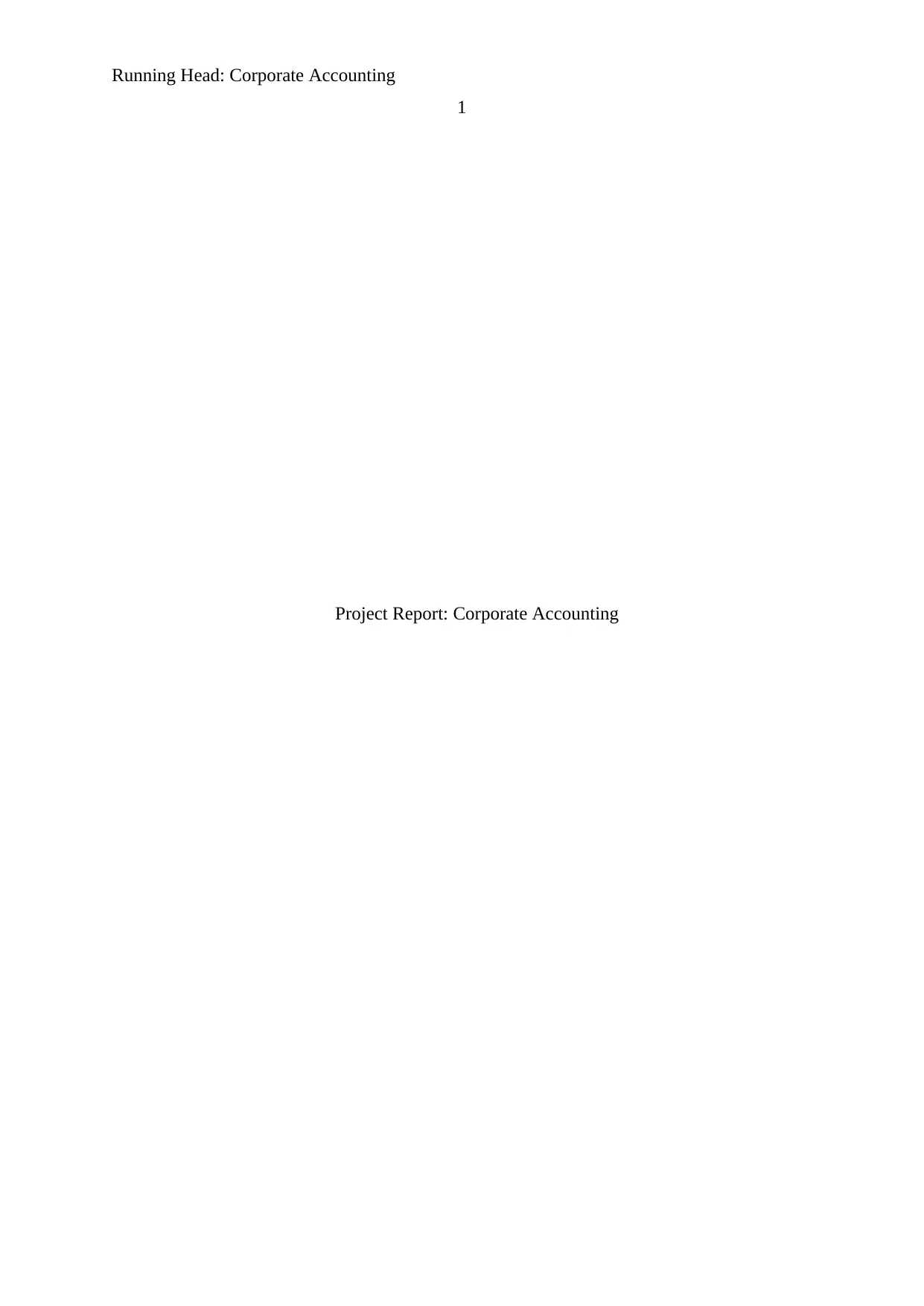
Running Head: Corporate Accounting
1
Project Report: Corporate Accounting
1
Project Report: Corporate Accounting
Paraphrase This Document
Need a fresh take? Get an instant paraphrase of this document with our AI Paraphraser
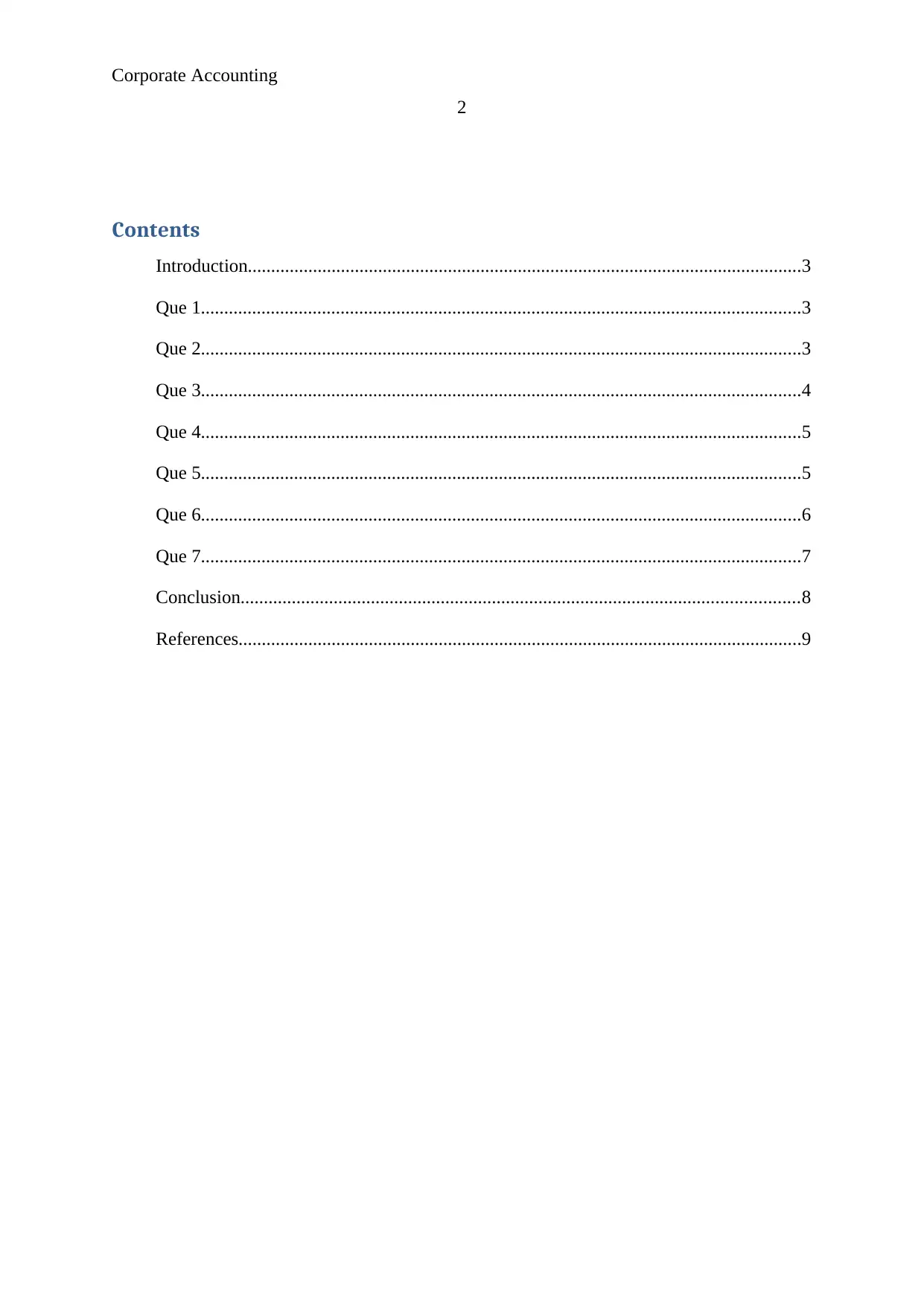
Corporate Accounting
2
Contents
Introduction.......................................................................................................................3
Que 1.................................................................................................................................3
Que 2.................................................................................................................................3
Que 3.................................................................................................................................4
Que 4.................................................................................................................................5
Que 5.................................................................................................................................5
Que 6.................................................................................................................................6
Que 7.................................................................................................................................7
Conclusion........................................................................................................................8
References.........................................................................................................................9
2
Contents
Introduction.......................................................................................................................3
Que 1.................................................................................................................................3
Que 2.................................................................................................................................3
Que 3.................................................................................................................................4
Que 4.................................................................................................................................5
Que 5.................................................................................................................................5
Que 6.................................................................................................................................6
Que 7.................................................................................................................................7
Conclusion........................................................................................................................8
References.........................................................................................................................9
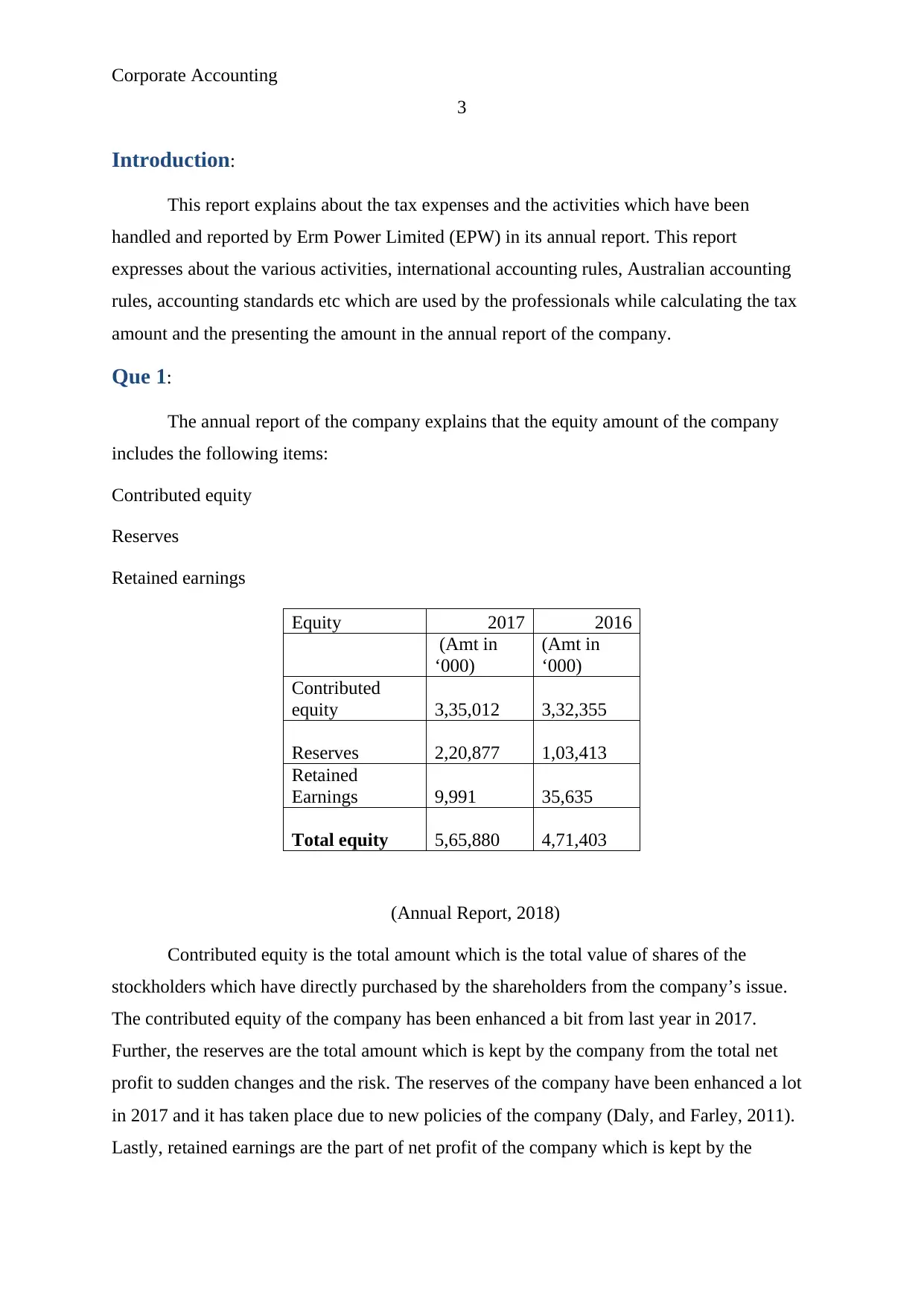
Corporate Accounting
3
Introduction:
This report explains about the tax expenses and the activities which have been
handled and reported by Erm Power Limited (EPW) in its annual report. This report
expresses about the various activities, international accounting rules, Australian accounting
rules, accounting standards etc which are used by the professionals while calculating the tax
amount and the presenting the amount in the annual report of the company.
Que 1:
The annual report of the company explains that the equity amount of the company
includes the following items:
Contributed equity
Reserves
Retained earnings
Equity 2017 2016
(Amt in
‘000)
(Amt in
‘000)
Contributed
equity 3,35,012 3,32,355
Reserves 2,20,877 1,03,413
Retained
Earnings 9,991 35,635
Total equity 5,65,880 4,71,403
(Annual Report, 2018)
Contributed equity is the total amount which is the total value of shares of the
stockholders which have directly purchased by the shareholders from the company’s issue.
The contributed equity of the company has been enhanced a bit from last year in 2017.
Further, the reserves are the total amount which is kept by the company from the total net
profit to sudden changes and the risk. The reserves of the company have been enhanced a lot
in 2017 and it has taken place due to new policies of the company (Daly, and Farley, 2011).
Lastly, retained earnings are the part of net profit of the company which is kept by the
3
Introduction:
This report explains about the tax expenses and the activities which have been
handled and reported by Erm Power Limited (EPW) in its annual report. This report
expresses about the various activities, international accounting rules, Australian accounting
rules, accounting standards etc which are used by the professionals while calculating the tax
amount and the presenting the amount in the annual report of the company.
Que 1:
The annual report of the company explains that the equity amount of the company
includes the following items:
Contributed equity
Reserves
Retained earnings
Equity 2017 2016
(Amt in
‘000)
(Amt in
‘000)
Contributed
equity 3,35,012 3,32,355
Reserves 2,20,877 1,03,413
Retained
Earnings 9,991 35,635
Total equity 5,65,880 4,71,403
(Annual Report, 2018)
Contributed equity is the total amount which is the total value of shares of the
stockholders which have directly purchased by the shareholders from the company’s issue.
The contributed equity of the company has been enhanced a bit from last year in 2017.
Further, the reserves are the total amount which is kept by the company from the total net
profit to sudden changes and the risk. The reserves of the company have been enhanced a lot
in 2017 and it has taken place due to new policies of the company (Daly, and Farley, 2011).
Lastly, retained earnings are the part of net profit of the company which is kept by the
⊘ This is a preview!⊘
Do you want full access?
Subscribe today to unlock all pages.

Trusted by 1+ million students worldwide
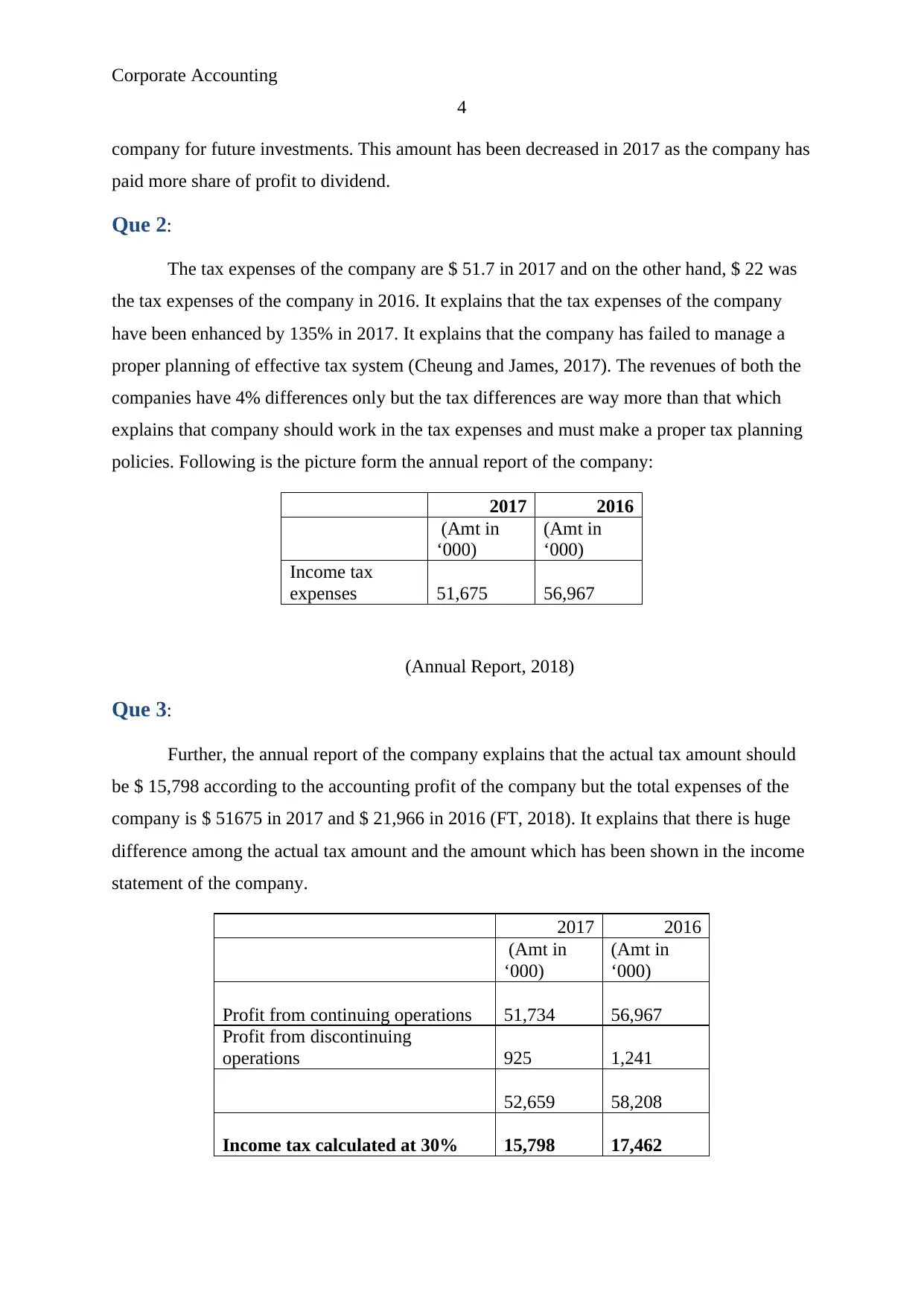
Corporate Accounting
4
company for future investments. This amount has been decreased in 2017 as the company has
paid more share of profit to dividend.
Que 2:
The tax expenses of the company are $ 51.7 in 2017 and on the other hand, $ 22 was
the tax expenses of the company in 2016. It explains that the tax expenses of the company
have been enhanced by 135% in 2017. It explains that the company has failed to manage a
proper planning of effective tax system (Cheung and James, 2017). The revenues of both the
companies have 4% differences only but the tax differences are way more than that which
explains that company should work in the tax expenses and must make a proper tax planning
policies. Following is the picture form the annual report of the company:
2017 2016
(Amt in
‘000)
(Amt in
‘000)
Income tax
expenses 51,675 56,967
(Annual Report, 2018)
Que 3:
Further, the annual report of the company explains that the actual tax amount should
be $ 15,798 according to the accounting profit of the company but the total expenses of the
company is $ 51675 in 2017 and $ 21,966 in 2016 (FT, 2018). It explains that there is huge
difference among the actual tax amount and the amount which has been shown in the income
statement of the company.
2017 2016
(Amt in
‘000)
(Amt in
‘000)
Profit from continuing operations 51,734 56,967
Profit from discontinuing
operations 925 1,241
52,659 58,208
Income tax calculated at 30% 15,798 17,462
4
company for future investments. This amount has been decreased in 2017 as the company has
paid more share of profit to dividend.
Que 2:
The tax expenses of the company are $ 51.7 in 2017 and on the other hand, $ 22 was
the tax expenses of the company in 2016. It explains that the tax expenses of the company
have been enhanced by 135% in 2017. It explains that the company has failed to manage a
proper planning of effective tax system (Cheung and James, 2017). The revenues of both the
companies have 4% differences only but the tax differences are way more than that which
explains that company should work in the tax expenses and must make a proper tax planning
policies. Following is the picture form the annual report of the company:
2017 2016
(Amt in
‘000)
(Amt in
‘000)
Income tax
expenses 51,675 56,967
(Annual Report, 2018)
Que 3:
Further, the annual report of the company explains that the actual tax amount should
be $ 15,798 according to the accounting profit of the company but the total expenses of the
company is $ 51675 in 2017 and $ 21,966 in 2016 (FT, 2018). It explains that there is huge
difference among the actual tax amount and the amount which has been shown in the income
statement of the company.
2017 2016
(Amt in
‘000)
(Amt in
‘000)
Profit from continuing operations 51,734 56,967
Profit from discontinuing
operations 925 1,241
52,659 58,208
Income tax calculated at 30% 15,798 17,462
Paraphrase This Document
Need a fresh take? Get an instant paraphrase of this document with our AI Paraphraser
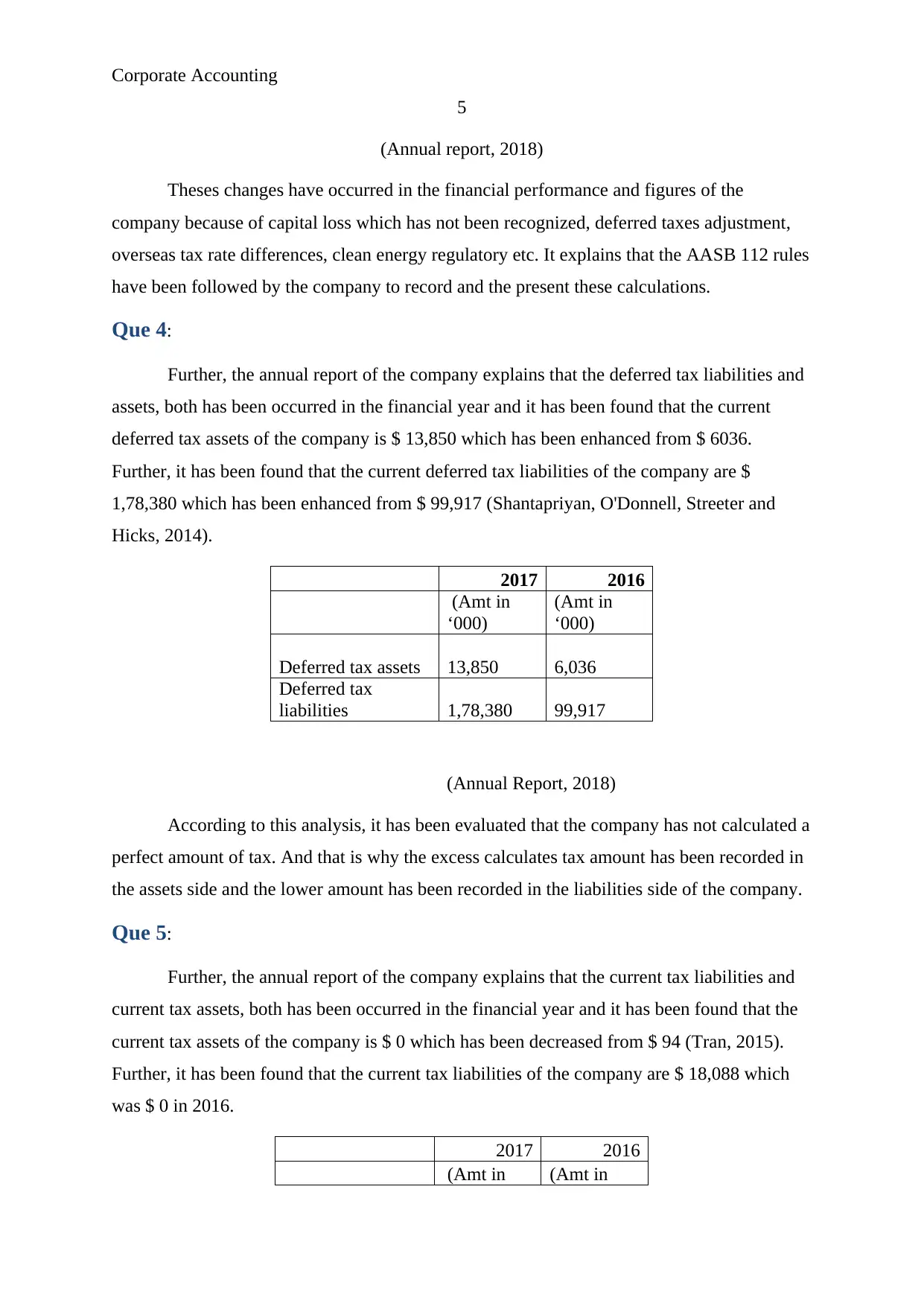
Corporate Accounting
5
(Annual report, 2018)
Theses changes have occurred in the financial performance and figures of the
company because of capital loss which has not been recognized, deferred taxes adjustment,
overseas tax rate differences, clean energy regulatory etc. It explains that the AASB 112 rules
have been followed by the company to record and the present these calculations.
Que 4:
Further, the annual report of the company explains that the deferred tax liabilities and
assets, both has been occurred in the financial year and it has been found that the current
deferred tax assets of the company is $ 13,850 which has been enhanced from $ 6036.
Further, it has been found that the current deferred tax liabilities of the company are $
1,78,380 which has been enhanced from $ 99,917 (Shantapriyan, O'Donnell, Streeter and
Hicks, 2014).
2017 2016
(Amt in
‘000)
(Amt in
‘000)
Deferred tax assets 13,850 6,036
Deferred tax
liabilities 1,78,380 99,917
(Annual Report, 2018)
According to this analysis, it has been evaluated that the company has not calculated a
perfect amount of tax. And that is why the excess calculates tax amount has been recorded in
the assets side and the lower amount has been recorded in the liabilities side of the company.
Que 5:
Further, the annual report of the company explains that the current tax liabilities and
current tax assets, both has been occurred in the financial year and it has been found that the
current tax assets of the company is $ 0 which has been decreased from $ 94 (Tran, 2015).
Further, it has been found that the current tax liabilities of the company are $ 18,088 which
was $ 0 in 2016.
2017 2016
(Amt in (Amt in
5
(Annual report, 2018)
Theses changes have occurred in the financial performance and figures of the
company because of capital loss which has not been recognized, deferred taxes adjustment,
overseas tax rate differences, clean energy regulatory etc. It explains that the AASB 112 rules
have been followed by the company to record and the present these calculations.
Que 4:
Further, the annual report of the company explains that the deferred tax liabilities and
assets, both has been occurred in the financial year and it has been found that the current
deferred tax assets of the company is $ 13,850 which has been enhanced from $ 6036.
Further, it has been found that the current deferred tax liabilities of the company are $
1,78,380 which has been enhanced from $ 99,917 (Shantapriyan, O'Donnell, Streeter and
Hicks, 2014).
2017 2016
(Amt in
‘000)
(Amt in
‘000)
Deferred tax assets 13,850 6,036
Deferred tax
liabilities 1,78,380 99,917
(Annual Report, 2018)
According to this analysis, it has been evaluated that the company has not calculated a
perfect amount of tax. And that is why the excess calculates tax amount has been recorded in
the assets side and the lower amount has been recorded in the liabilities side of the company.
Que 5:
Further, the annual report of the company explains that the current tax liabilities and
current tax assets, both has been occurred in the financial year and it has been found that the
current tax assets of the company is $ 0 which has been decreased from $ 94 (Tran, 2015).
Further, it has been found that the current tax liabilities of the company are $ 18,088 which
was $ 0 in 2016.
2017 2016
(Amt in (Amt in
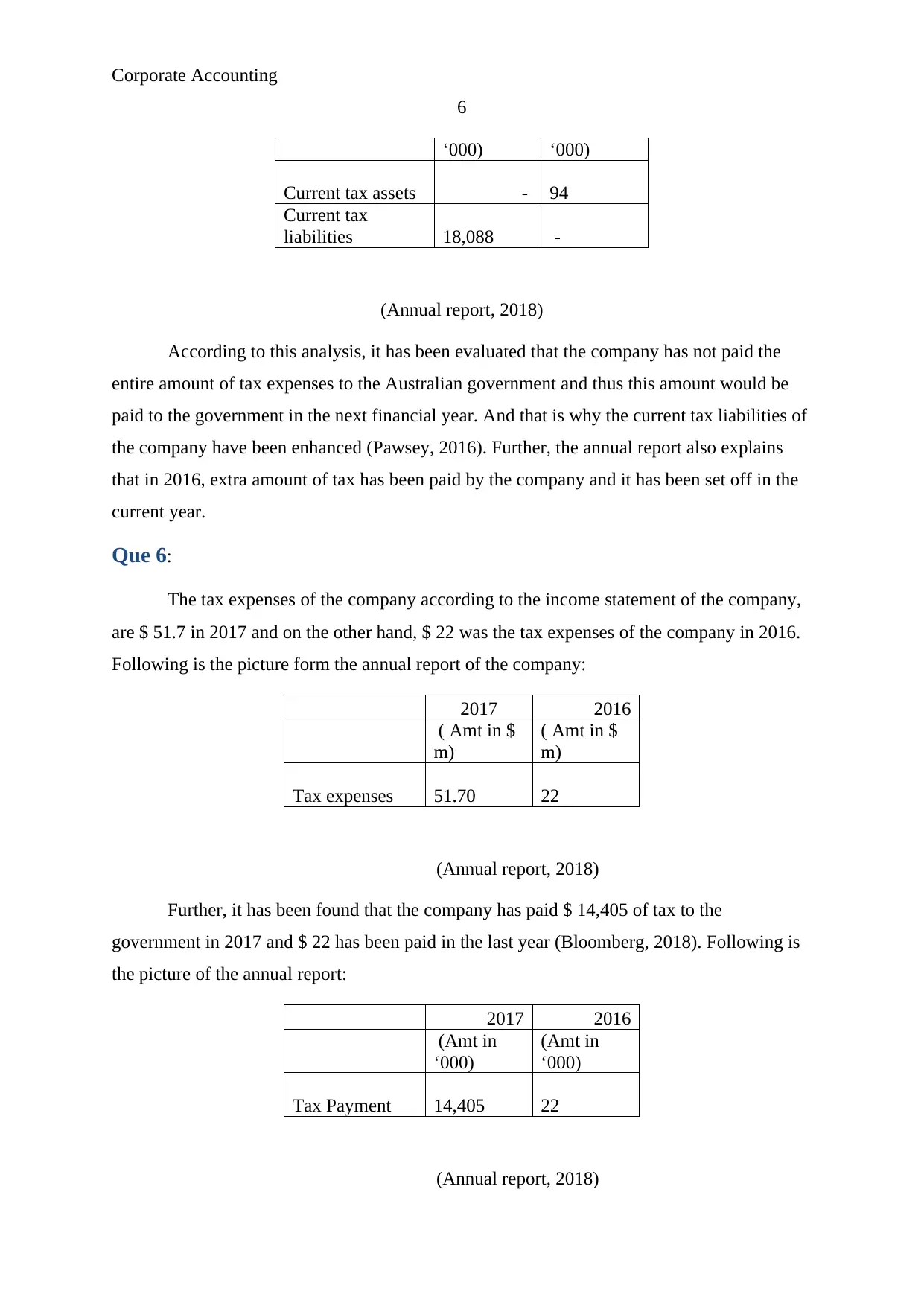
Corporate Accounting
6
‘000) ‘000)
Current tax assets - 94
Current tax
liabilities 18,088 -
(Annual report, 2018)
According to this analysis, it has been evaluated that the company has not paid the
entire amount of tax expenses to the Australian government and thus this amount would be
paid to the government in the next financial year. And that is why the current tax liabilities of
the company have been enhanced (Pawsey, 2016). Further, the annual report also explains
that in 2016, extra amount of tax has been paid by the company and it has been set off in the
current year.
Que 6:
The tax expenses of the company according to the income statement of the company,
are $ 51.7 in 2017 and on the other hand, $ 22 was the tax expenses of the company in 2016.
Following is the picture form the annual report of the company:
2017 2016
( Amt in $
m)
( Amt in $
m)
Tax expenses 51.70 22
(Annual report, 2018)
Further, it has been found that the company has paid $ 14,405 of tax to the
government in 2017 and $ 22 has been paid in the last year (Bloomberg, 2018). Following is
the picture of the annual report:
2017 2016
(Amt in
‘000)
(Amt in
‘000)
Tax Payment 14,405 22
(Annual report, 2018)
6
‘000) ‘000)
Current tax assets - 94
Current tax
liabilities 18,088 -
(Annual report, 2018)
According to this analysis, it has been evaluated that the company has not paid the
entire amount of tax expenses to the Australian government and thus this amount would be
paid to the government in the next financial year. And that is why the current tax liabilities of
the company have been enhanced (Pawsey, 2016). Further, the annual report also explains
that in 2016, extra amount of tax has been paid by the company and it has been set off in the
current year.
Que 6:
The tax expenses of the company according to the income statement of the company,
are $ 51.7 in 2017 and on the other hand, $ 22 was the tax expenses of the company in 2016.
Following is the picture form the annual report of the company:
2017 2016
( Amt in $
m)
( Amt in $
m)
Tax expenses 51.70 22
(Annual report, 2018)
Further, it has been found that the company has paid $ 14,405 of tax to the
government in 2017 and $ 22 has been paid in the last year (Bloomberg, 2018). Following is
the picture of the annual report:
2017 2016
(Amt in
‘000)
(Amt in
‘000)
Tax Payment 14,405 22
(Annual report, 2018)
⊘ This is a preview!⊘
Do you want full access?
Subscribe today to unlock all pages.

Trusted by 1+ million students worldwide
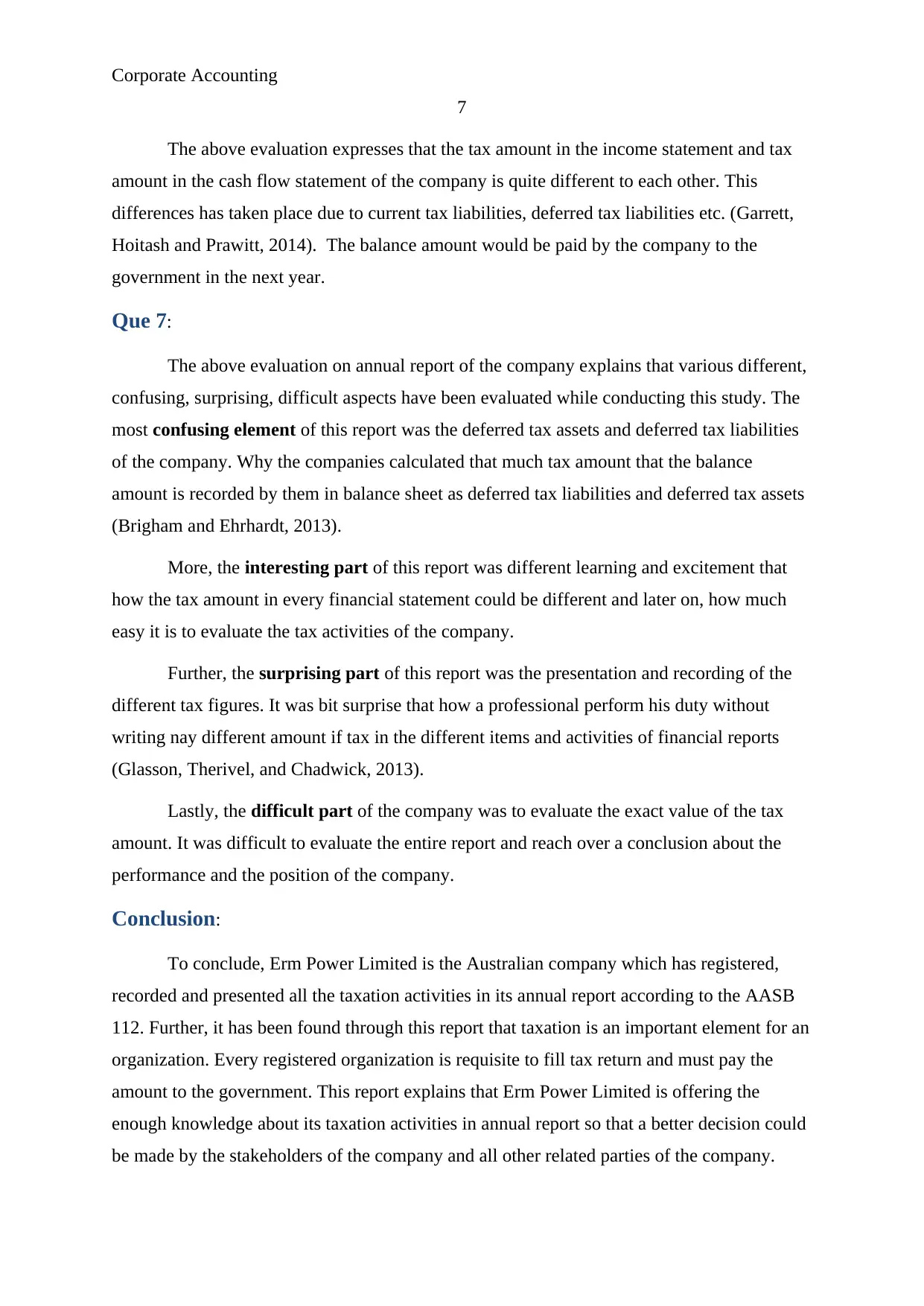
Corporate Accounting
7
The above evaluation expresses that the tax amount in the income statement and tax
amount in the cash flow statement of the company is quite different to each other. This
differences has taken place due to current tax liabilities, deferred tax liabilities etc. (Garrett,
Hoitash and Prawitt, 2014). The balance amount would be paid by the company to the
government in the next year.
Que 7:
The above evaluation on annual report of the company explains that various different,
confusing, surprising, difficult aspects have been evaluated while conducting this study. The
most confusing element of this report was the deferred tax assets and deferred tax liabilities
of the company. Why the companies calculated that much tax amount that the balance
amount is recorded by them in balance sheet as deferred tax liabilities and deferred tax assets
(Brigham and Ehrhardt, 2013).
More, the interesting part of this report was different learning and excitement that
how the tax amount in every financial statement could be different and later on, how much
easy it is to evaluate the tax activities of the company.
Further, the surprising part of this report was the presentation and recording of the
different tax figures. It was bit surprise that how a professional perform his duty without
writing nay different amount if tax in the different items and activities of financial reports
(Glasson, Therivel, and Chadwick, 2013).
Lastly, the difficult part of the company was to evaluate the exact value of the tax
amount. It was difficult to evaluate the entire report and reach over a conclusion about the
performance and the position of the company.
Conclusion:
To conclude, Erm Power Limited is the Australian company which has registered,
recorded and presented all the taxation activities in its annual report according to the AASB
112. Further, it has been found through this report that taxation is an important element for an
organization. Every registered organization is requisite to fill tax return and must pay the
amount to the government. This report explains that Erm Power Limited is offering the
enough knowledge about its taxation activities in annual report so that a better decision could
be made by the stakeholders of the company and all other related parties of the company.
7
The above evaluation expresses that the tax amount in the income statement and tax
amount in the cash flow statement of the company is quite different to each other. This
differences has taken place due to current tax liabilities, deferred tax liabilities etc. (Garrett,
Hoitash and Prawitt, 2014). The balance amount would be paid by the company to the
government in the next year.
Que 7:
The above evaluation on annual report of the company explains that various different,
confusing, surprising, difficult aspects have been evaluated while conducting this study. The
most confusing element of this report was the deferred tax assets and deferred tax liabilities
of the company. Why the companies calculated that much tax amount that the balance
amount is recorded by them in balance sheet as deferred tax liabilities and deferred tax assets
(Brigham and Ehrhardt, 2013).
More, the interesting part of this report was different learning and excitement that
how the tax amount in every financial statement could be different and later on, how much
easy it is to evaluate the tax activities of the company.
Further, the surprising part of this report was the presentation and recording of the
different tax figures. It was bit surprise that how a professional perform his duty without
writing nay different amount if tax in the different items and activities of financial reports
(Glasson, Therivel, and Chadwick, 2013).
Lastly, the difficult part of the company was to evaluate the exact value of the tax
amount. It was difficult to evaluate the entire report and reach over a conclusion about the
performance and the position of the company.
Conclusion:
To conclude, Erm Power Limited is the Australian company which has registered,
recorded and presented all the taxation activities in its annual report according to the AASB
112. Further, it has been found through this report that taxation is an important element for an
organization. Every registered organization is requisite to fill tax return and must pay the
amount to the government. This report explains that Erm Power Limited is offering the
enough knowledge about its taxation activities in annual report so that a better decision could
be made by the stakeholders of the company and all other related parties of the company.
Paraphrase This Document
Need a fresh take? Get an instant paraphrase of this document with our AI Paraphraser
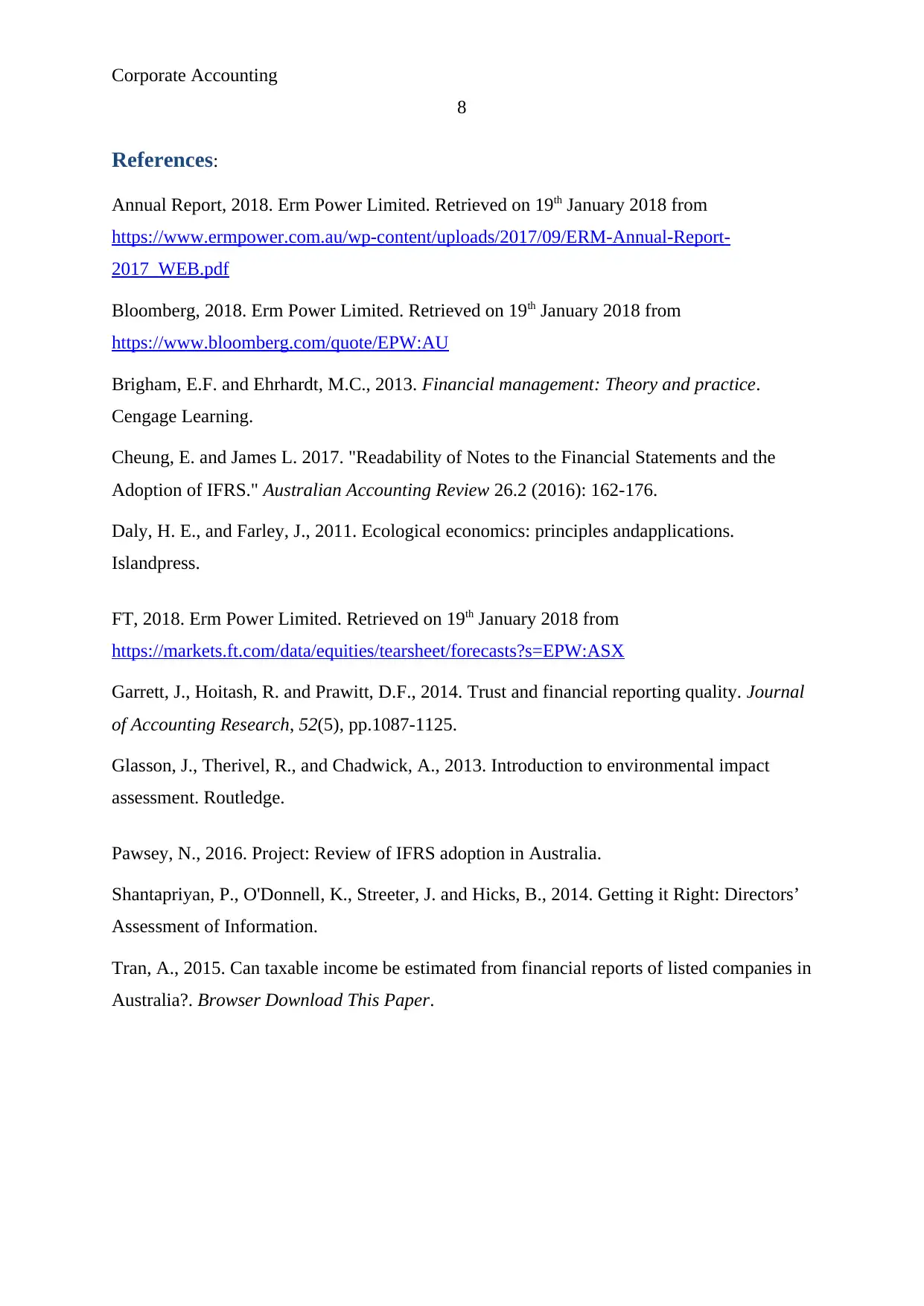
Corporate Accounting
8
References:
Annual Report, 2018. Erm Power Limited. Retrieved on 19th January 2018 from
https://www.ermpower.com.au/wp-content/uploads/2017/09/ERM-Annual-Report-
2017_WEB.pdf
Bloomberg, 2018. Erm Power Limited. Retrieved on 19th January 2018 from
https://www.bloomberg.com/quote/EPW:AU
Brigham, E.F. and Ehrhardt, M.C., 2013. Financial management: Theory and practice.
Cengage Learning.
Cheung, E. and James L. 2017. "Readability of Notes to the Financial Statements and the
Adoption of IFRS." Australian Accounting Review 26.2 (2016): 162-176.
Daly, H. E., and Farley, J., 2011. Ecological economics: principles andapplications.
Islandpress.
FT, 2018. Erm Power Limited. Retrieved on 19th January 2018 from
https://markets.ft.com/data/equities/tearsheet/forecasts?s=EPW:ASX
Garrett, J., Hoitash, R. and Prawitt, D.F., 2014. Trust and financial reporting quality. Journal
of Accounting Research, 52(5), pp.1087-1125.
Glasson, J., Therivel, R., and Chadwick, A., 2013. Introduction to environmental impact
assessment. Routledge.
Pawsey, N., 2016. Project: Review of IFRS adoption in Australia.
Shantapriyan, P., O'Donnell, K., Streeter, J. and Hicks, B., 2014. Getting it Right: Directors’
Assessment of Information.
Tran, A., 2015. Can taxable income be estimated from financial reports of listed companies in
Australia?. Browser Download This Paper.
8
References:
Annual Report, 2018. Erm Power Limited. Retrieved on 19th January 2018 from
https://www.ermpower.com.au/wp-content/uploads/2017/09/ERM-Annual-Report-
2017_WEB.pdf
Bloomberg, 2018. Erm Power Limited. Retrieved on 19th January 2018 from
https://www.bloomberg.com/quote/EPW:AU
Brigham, E.F. and Ehrhardt, M.C., 2013. Financial management: Theory and practice.
Cengage Learning.
Cheung, E. and James L. 2017. "Readability of Notes to the Financial Statements and the
Adoption of IFRS." Australian Accounting Review 26.2 (2016): 162-176.
Daly, H. E., and Farley, J., 2011. Ecological economics: principles andapplications.
Islandpress.
FT, 2018. Erm Power Limited. Retrieved on 19th January 2018 from
https://markets.ft.com/data/equities/tearsheet/forecasts?s=EPW:ASX
Garrett, J., Hoitash, R. and Prawitt, D.F., 2014. Trust and financial reporting quality. Journal
of Accounting Research, 52(5), pp.1087-1125.
Glasson, J., Therivel, R., and Chadwick, A., 2013. Introduction to environmental impact
assessment. Routledge.
Pawsey, N., 2016. Project: Review of IFRS adoption in Australia.
Shantapriyan, P., O'Donnell, K., Streeter, J. and Hicks, B., 2014. Getting it Right: Directors’
Assessment of Information.
Tran, A., 2015. Can taxable income be estimated from financial reports of listed companies in
Australia?. Browser Download This Paper.
1 out of 8
Related Documents
Your All-in-One AI-Powered Toolkit for Academic Success.
+13062052269
info@desklib.com
Available 24*7 on WhatsApp / Email
![[object Object]](/_next/static/media/star-bottom.7253800d.svg)
Unlock your academic potential
Copyright © 2020–2025 A2Z Services. All Rights Reserved. Developed and managed by ZUCOL.





